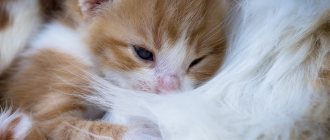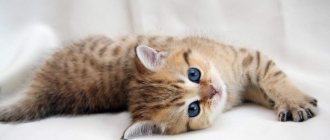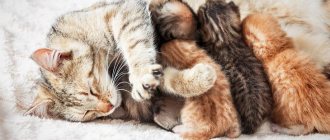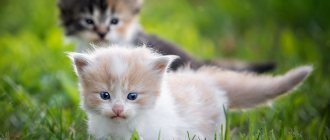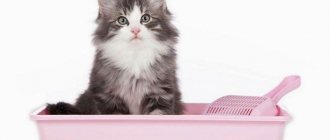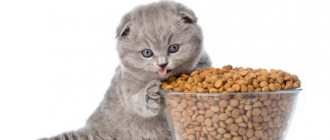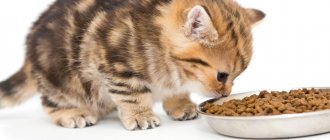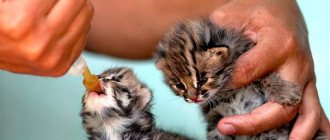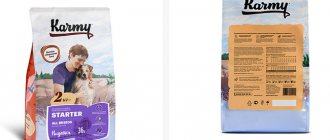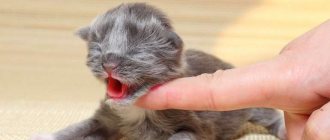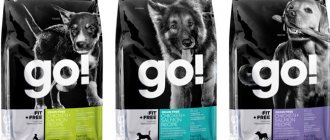- Cats
What to feed a kitten? It would seem like a simple question. Meat, milk, leftover soup and fried fish from the holiday dinner, or better yet, the popular Whiskas, which, according to the advertisement, has become even tastier.
Alas, in reality everything turns out to be not so simple. Many of the foods that we are used to giving our pets are harmful to them. As for cheap, but well-known foods, it is better not to buy them at all, unless you value the health of your tailed baby. There are some nuances in how many times to feed a kitten, and many other tricks that affect the healthy growth of the animal.
Kitten feeding regimen
To begin with, it is important to understand when to introduce complementary foods and how often to feed the kitten. You, of course, can be guided by the kitten's hungry look, but it is better not to awaken the beast in him, and 3-4 weeks after birth, begin to gradually feed the baby.
By 4 weeks of age, a stable eating schedule should be established.
The baby should receive additional feeding 4-7 times a day.
But there are stalemate situations when kittens need additional feeding much more often.
How many times a day should you feed your kitten?
- age up to 2 weeks – 10 times a day (with night coverage);
- feeding a one-month-old kitten – 8 times a day (including the night);
- 1 - 2 months - 7 times a day (night is already excluded);
- 2 - 3 months - 6 times a day;
- 4 months - 5 months - 5 times a day;
- 5 - 9 months - 4 times a day;
- 9 - 12 months - 3 times a day;
- Feeding kittens from 1 year of age becomes twice a day (for example, 9:00 – 21:00).
How much food to give a kitten:
- Age 1 week – 30 ml per 100 g of kitten weight;
- 2 weeks – 38 ml per 100 g of kitten’s weight;
- 3 weeks – 48 ml per 100 g of kitten’s weight;
- 4 weeks and subsequent – 48-53 ml per 100 grams of kitten weight.
How much should a kitten receive per day?
Of course, it’s easy to calculate the amount of feed based on the items already proposed, but we’ll make the task easier and give a few numbers:
- At 1.5 months, a baby needs about 120 grams of food per day;
- We feed a two-month-old kitten more - 160-180 grams per day;
- During the period of active growth (3 months - 6 months), the daily food intake is 180-240 grams, with at least 40 grams of meat;
- A six-month-old baby needs up to 180 grams of food per day;
- At 10-12 months, the period when the kitten’s activity decreases, the daily food intake is 150-200 grams.
It is important to give vitamins to your pet.
Feeding kittens from 0 to 6 months Childbirth, although natural, is an absolutely unpredictable process. Complications associated with labor often lead the mother to the operating table or force her to undergo drug treatment. It doesn’t matter for what reasons kittens are left without mother’s milk, it is important to know what to do next and how to properly feed the kitten with a pipette.
- Ancient dog breeds
- Dog's sense of smell
- Maine Coon
- Domestic iguana
- How much does a raccoon cost?
- Interesting facts about cats
If the birth is planned, buy a bag of cat milk replacer; if you don’t need it for kittens, give it to mom, she won’t mind the extra vitamins and protein. During the “season” for the birth of stray kittens, abandoned newborn babies are often found. When you find a find, act quickly - ask, buy, but find food for the kittens!
Cat's milk consists of 50% protein, and its complete analogues do not exist. Suitable for feeding are cat milk substitutes (sold in pet stores), infant formula without additives and sugar, natural condensed milk without sugar (prepared at home), products for newborns from the “dairy kitchen”, goat milk, in extreme cases - homemade cow milk.
You will need a pipette, an insulin syringe with a soft plunger, or a special nipple for feeding. A well-washed and boiled tube of naphthysin or other drops and a rubber band from a pipette as a pacifier will be suitable for available means. Make sure that the elastic band is held very tightly and is made of medical latex!
If a kitten has swallowed a piece of latex, drop 1-2 drops of Vaseline oil into the animal’s mouth every 2 hours. Fat envelops the disintegrating latex and removes it from the body.
If you decide to syringe feed your kittens, practice; the milk should be squeezed out drop by drop. A kitten’s protective reflexes are weaker than those of adult animals; a choked baby is almost impossible to resuscitate.
It is advisable to feed the kittens in a natural position - the animal lies on its stomach, rests its hind legs on the floor, and tramples the side with its front legs. One option is a cat litter box with a low side, covered with several layers of fabric or a thick towel.
For the first 3 days, kittens eat every 2 hours, day and night. After surviving 3 days, switch the kittens to food once every 4 hours.
The milk must be warm! 30–39 C° in the first 3 days, not lower than 30 C° in subsequent days.
Feed the kitten until he stops sucking; most often, after eating, kittens immediately fall asleep. At your discretion, before or after feeding, gently massage the tummy and area under the tail with a damp, warm cloth or cotton swab until the baby defecates. This stage is extremely important; kittens cannot empty their intestines and bladder without stimulation - licking or its imitation. After defecation, the kitten needs to be fed.
Kittens should be in a warm nest (temperature no lower than 25 C°) with dim lighting until their eyes are fully open; kittens do not tolerate bright light.
For full development, kittens need to crawl and be in contact with their mother. Place a heating pad wrapped in wool in the nest, using a stuffed toy as a “reservoir” for the heating pad.
By month
At each age, a kitten’s nutrition has its own characteristics. Not only the portions and frequency of giving food change, but also its composition. Its future health depends on how well a cat eats in childhood. When a kitten is purchased from a breeder, he gives the owner the necessary recommendations on the pet’s nutrition that should be followed.
Natural food
Natural food for kittens and cats is chosen more often than industrial food. Some breeders raise babies on natural food for up to 2-3 months, and then gradually switch to industrial diets, since their use is more convenient for the owners.
Little kittens drink milk
from 1.5 to 2 months
The stomach and intestines of a one and a half month old kitten learn to digest food, and therefore the baby’s food should be easily digestible and not irritate the mucous membranes. Food is given liquid and semi-liquid.
Solid food is still prohibited during this period. If the cat has enough milk, then first the kitten is given fermented milk products with egg yolk. The boiled yolk is pounded and mixed with fermented baked milk or yogurt.
After the first week of such complementary feeding, they begin to give meat puree (if the cat does not have enough milk, then they begin to give puree at the same time as dairy products). It is prepared from lean boiled meat, which is ground in a blender and mixed with a small amount of broth to give the food the desired semi-liquid consistency. When the kitten begins to eat confidently enough, which usually happens closer to 2 months, you can give the meat without adding broth and grind it less finely.
Be sure to prepare liquid porridge. They are boiled in water or milk, which is diluted half with water. You can give kittens buckwheat, rice and oatmeal, after grinding them until a homogeneous mass with the consistency of fermented baked milk is obtained. The porridge should be prepared without salt and sugar. It is useful to add a little honey to it to enrich it with vitamins and minerals.
For your information! Kittens at one and a half months old need to change their water at least 2 times a day.
2 to 3 months
At this time, you can move on to feeding denser foods. For a two-month-old kitten, the boiled meat is already finely chopped, and grated carrots, pumpkin or cucumbers are added to it. Porridges are prepared in the same way as in the previous age with a large amount of liquid, but it is no longer necessary to grind the cereals too much. The porridge should remain liquid, and a homogeneous mass is no longer required.
Advice! Milk and dairy products should account for 50% of the diet.
It is impossible to reduce the number of feedings to less than 6. If the owner’s work schedule does not allow him to provide the pet with regular food, then it is necessary to resort to the free feeding method. In such a situation, the kitten should always have a small amount of fermented baked milk or kefir in its bowl so that it can eat as soon as it feels hungry. In this case, full feeding is carried out at least 4 times. This method is treated as an exception, therefore, if it is possible to feed the kitten regularly, it should not be used.
3 to 4 months
At this age, the kitten is already beginning to adapt to eating adult food. The amount of dairy products in his diet is reduced to ¼ of the total. Whole milk is gradually completely eliminated from the diet. This is due to the fact that by this age the enzyme that ensures the breakdown of lactose ceases to be produced, and therefore milk begins to cause digestive problems and diarrhea. Porridge is also cooked with plenty of water and the cereal is not ground. The meat is no longer cut so finely. Vegetables are still provided.
Whiskas dry food
4 to 5 months
The diet becomes the same as that of adult cats, but the supply of food still remains more frequent than theirs. The consistency of the food also differs.
It still shouldn't be very stiff. Porridges are prepared with a moderate amount of water, and the meat is cut quite coarsely. Among dairy products, preference is given to cottage cheese with a fat content of 5 to 9%.
There are cats that eat soft and liquid food all their lives. This is not a deviation. If the kitten, in the absence of pathologies, refuses solid foods, then you should simply continue feeding food with the same consistency as before.
5 to 6 months
The vast majority of a cat's diet consists of solid food. Porridge is prepared according to standard standards, as for humans. Little by little, the pet begins to be offered pieces of lean raw meat. Cats are carnivores, and they need this diet to maintain a healthy stomach. Otherwise, feeding remains the same as up to 5 months.
From 6 to 12 months
The main difference between a kitten’s diet at this age is the inclusion of a significant amount of raw meat in the diet. It should be at least 50% of the total volume of meat food. The rest of the diet is the same as before.
Industrial
You can feed a kitten with ready-made industrial food from an early age, since most reputable manufacturers have food for cats and products for babies in their lines.
1 to 2 months
During this period, feeding is carried out with special pates for kittens from a month to two months. They have a very delicate consistency that does not irritate the mucous membranes. Also during this period, cat milk substitutes are given if the cat does not have enough of it. The number of feedings per day is unchanged for both natural and industrial feeds. If the baby cannot yet start eating the pate because its consistency is not very liquid, then it should be diluted a little with boiled water. Gradually the amount of water is reduced so that by 2 months the pate is given in the form in which it is produced. If the pet eats food without adding water, then it is not required to use it, even at the very beginning of complementary feeding.
2 to 3 months
Dry kitten food is gradually added to the pate. They should definitely be soaked. This is required because the pet cannot yet fully chew hard pieces and there is a high risk that he will choke. The volume of soaked dry food should not exceed 20% of the total nutrition.
3 to 4 months
Pate for kittens is complemented by soft food, which is also intended for feeding babies. In addition, dry food is also given - slightly soaked at the beginning of the period, and dry at the end.
From 4 to one year
Pate is completely replaced with wet food. These can be portioned foods in bags or canned goods in jars. The latter option is cheaper, but after opening the product should be stored for no more than a day in the refrigerator, transferred to glass. Because of this, if the pet is a small one, jars may be inconvenient, since some of the food will remain uneaten and will have to be thrown away after a day. Dry food for kittens is no longer soaked.
From this moment onwards up to a year the diet remains the same. After 1 year, the cat becomes an adult, its active growth and development stops. From this age she should be given adult food. You need to choose a product from the same manufacturer as for the kitten. This will significantly speed up the period of your pet’s adaptation to the new diet. The cat should be switched to adult food gradually, replacing more and more of the kitten food with adult food every day for a week.
If you have spayed an older kitten, her diet should change. Read the special article on feeding sterilized cats.
Spiders for small kittens
Food basket for kittens
Let's look at the cat's “food basket” - what you can feed kittens from homemade food, that is, “natural food”. The first thing is meat, namely beef. A bird would also work. It is better to avoid pork; a kitten can easily overeat it out of habit; on top of everything else, it is a source of helminthiasis infection. If we talk about fish, there is nothing better than sea fish. You can get a lot of things from river fish. But even sea fish should be given infrequently - a couple of times a week is more than enough. For young creatures, the meat must be boiled, but older pets can eat it raw, but only in moderation.
What better way to feed a kitten than with milk; there is simply no dearer food for it. However, not every cat will drink cow's milk. In some animals, the stomach simply cannot tolerate it. In such cases, the baby can be given yogurt or other fermented milk product. The main thing is that its fat content is not too high. Another good product for a growing animal is cottage cheese. Small pets are given cottage cheese puree with yolk, milk, or all together. Few people will refuse such “mogol-mogol” and usually the kitten devolves it with great pleasure. You can also pamper your pet with rennet cheese and sour cream.
In order for an animal to develop fully, it requires fiber contained in products of plant origin - these are vegetables and cereals. To compensate for this need, the kitten needs to cook porridge. For the smallest kittens, on a milk basis, and for older animals on meat, chicken, and fish broths. Only legumes should be avoided, since it has already been mentioned that feeding legumes leads to bloating and constipation, and they are also poorly absorbed by the body. Meat and vegetables are added to porridges made with meat broths.
Don't forget that your baby should have 24/7 access to fresh water. This aspect is especially important when feeding dry food. After all, cats that consume store-bought food drink almost four times more water than animals that eat natural products. Change the water regularly, and wash the container underneath and scald it with hot water.
Vitamins and supplements
When kept on high-quality, industrial feed, vitamins and additives are not required
It is important to understand that an excess of vitamins and microelements is no less dangerous than their deficiency. With a natural feeding method, vitamin supplements should be present in the diet on an ongoing basis at least until the age of one year.
A kitten can get basic vitamins and nutrients from natural products:
- Meat and bone meal.
- Fish, chicken, beef liver.
- Greens, vegetables, fruits.
- Sunflower oil, olive oil.
- Brewer's yeast.
Taurine is a rare amino acid that is found in small quantities in:
- Turkey.
- Rabbit.
- Chicken heart and liver.
- Beef heart.
- Pork, after deep freezing.
- Boiled pork liver.
- Ocean fish and shellfish.
- Raw red fish.
- Live homemade yogurt.
- Whole milk.
Do not forget that pharmaceutical products are also sources of vitamins and nutrients:
- Fish fat.
- Feed tricalcium phosphate.
- Omega-3, Omega-6.
- B vitamins.
To make life easier for owners, stores and veterinary pharmacies sell basic vitamin complexes containing essential nutrients and taurine. Veterinarians recommend choosing several complexes with a short composition, but alternating them on an ongoing basis.
Which food is better for kittens - dry or wet?
The opinions of different experts regarding the issue of artificial food do not agree: there are many pros and cons of such a diet. Each owner makes his own decision regarding the diet of his beloved pet and, if you prefer special canned food or dry pads, you must choose what food to feed the kitten. There is no significant difference between the two types of cat food, however, there are more cases of animal poisoning among those who eat canned food.
When choosing, you should take into account the age and breed of the animal. Many food manufacturers provide the addition of various substances for hair growth, which is important for British and Scottish folds, but completely useless for sphinxes. Feeding a kitten canned food for adult cats is fraught with indigestion and other side effects, so it is important to pay attention to the recommended age indicated on the package.
Advantages
Each feeding option usually has its pros and cons. It’s probably worth starting with the main advantages of this type of nutrition:
- The opportunity for the owner to select products for preparing food for kittens, focusing on their freshness and quality. This allows you to have more confidence that the prepared food is healthy for the baby.
- The food that is intended for the animal is always fresh, there are no chemicals in it, and therefore it will not only be useful for the still weak body, but also safe.
- The pet receives a variety of food daily.
- This food does not contribute to the development of addiction, the kitten will not suffer from painful addiction. Some foods can be freely replaced with others without causing stress to the kitten.
Flaws
As for the negative aspects of natural feeding of an animal, the following main points should be highlighted:
- It is necessary to carefully monitor that the diet does not contain foods that are undesirable, or even dangerous, for the kitten’s digestive system.
- Ordinary food does not always contain enough vitamins necessary for the normal development of a kitten at two months of age. To balance the diet, you will have to buy them specially and, after calculating the dose yourself, add them to your cat’s dishes.
But regardless of the option you choose to feed your pet, protein should be the basis of nutrition. Only they participate in the construction of a living organism. Therefore, the diet should consist of foods that are rich in protein, in a proportion of approximately more than half of the daily diet. Fish and meat products have a sufficient amount of protein.
But not only protein foods should be included in the baby’s diet. It is necessary to ensure that it contains various vitamins and microelements in sufficient quantities. The kitten's body is growing and it needs to have plenty of calcium, which promotes tooth growth and skeletal development. These substances are found in whole milk and fermented milk products. Knowing what a kitten should eat for 2 months and what should be removed from its diet, the baby’s owner will be able to confidently create a high-quality diet that will include necessary and healthy natural products.
Features by breed
Depending on the breed of cat, there are some differences in the nutrition of kittens. Owners of British, fold-eared and hairless breeds should pay special attention to this.
Fold
The main feature when feeding such kittens is that they need food 6 times a day for up to 3 months. Since these babies have an increased tendency to diseases of the urinary system and joints, it is better for them to choose a super-premium industrial diet. It will contain everything you need, and will also exclude substances that may increase the risk of pathologies. The belief that high doses of calcium in the diet will cause a kitten's ears to stand up is erroneous.
British
Due to their rapid growth and dense build, representatives of the breed require food with high calorie content from childhood. Meat in their diet should make up 65% of the total volume. It is also worth remembering that if you often feed liver, kelp and carrots to a kitten with a special blue color, it will begin to change somewhat.
Hairless kitten
Bald
These kittens have a very sensitive digestive system and also have a high risk of obesity. Due to a predisposition to gaining excess weight, a baby of the Don Sphynx, Elf, Bambino, Dwelf, Minskin, Ukrainian Levkoy or Canadian Sphynx breeds must be fed in strictly dosed quantities, and his bowl must be removed at regular intervals so that food is not constantly available.
Also, due to the lack of fur, hairless breed cats require more calories to maintain the required body temperature than other cats. Because of this, meat in their diet is at least 65%, just like the British or Chinchillas. To maintain good skin condition, you should enrich your diet with B vitamins, zinc and polyunsaturated acids.
There are many difficulties, so we wrote a separate article about the nutrition of hairless cats. You can read it here.
Consequences of poor nutrition
Poor nutrition, especially during the growth period, is the cause of many diseases and disorders:
- Stunted growth;
- Incorrect formation of the skeleton;
- Metabolic disorders;
- Reduced immunity;
- Allergic reactions;
- Poisoning;
- Worm infestations;
- Reproductive dysfunction.
Without following the basic rules and norms of feeding, it is impossible to raise a healthy animal that meets all the characteristics of the breed.
What should kittens not be given during their growth period?
- Cow's milk is not suitable for kittens; it does not provide the body's basic needs and is difficult to digest.
- Raw river fish – causes a lack of vitamin B and helminthic infestations.
- Fermented milk and dairy products with a high fat content.
- Fatty meats, pork.
- Sausages, smoked meats, products containing salt and spices.
- Potatoes and legumes are not digestible by cats; in addition, legumes cause fermentation in the intestines.
- Flour products and sweets do not bring any benefit to the body and contribute to excess weight gain.
- Chocolate is dangerous for cats and contains a substance that is toxic to this type of animal.
Natural nutrition
Those who adhere to the position of feeding kittens with natural food are confident that only such food is safe and healthy for them. Naturally, for them there is no question of what to feed the baby at this age, since they have already made their choice. However, it is worth noting that natural foods that are considered acceptable for kittens are not at all the same products that humans consume. This is a specially produced food that contains useful substances and no chemical additives.
Acana and Orijen: biologically appropriate diets for kittens
All Champion Petfoods foods are complete, biologically appropriate, contain a high proportion of fresh meat and natural nutritional supplements, making them suitable for feeding cats of all ages.
- Acana dry food is represented by three products: based on free-range poultry meat (chickens, turkeys, ducks), farm lamb and freshly caught ocean fish. Their composition fully meets the requirements for the feeding diet of kittens: the proportion of meat components is 75%, fat content is 20%, the formula contains pre- and probiotics. The balance of minerals, vitamins and other beneficial substances meets AAFCO standards. The size of the granules is about 10 mm. If your kitten is very tiny, you can grind them a little at first, however, this size does not cause any problems for pets older than 2 months.
- The Orijen line has no less advantages than Acana, only the share of meat components reaches 85%. In addition, Orijen also offers a special diet for kittens , in which the granules are slightly smaller - 8 mm each. It is created from meat and offal of turkey, chicken, sardines, flounder - the composition, if you look, is extremely rich.
According to the Acana and Orijen food tables, small kittens (up to 20 weeks) should be given 60 g of dry food per 1 kg of weight, and then gradually reduce the norm and reach a dosage of 30 g per kg of weight by six months. You will understand that you need to reduce the portions if, after 24 hours, there are still some granules left in the bowl.
Ready-made food for kittens
Today, there are a lot of ready-made food for kittens. Whether to give such food to a pet is a personal matter for the owner.
If you decide to introduce ready-made food into your kitten’s diet, you should remember the following rules:
- Under no circumstances should you give your pet food from different manufacturers. You should choose one, the most optimal food for regular feeding of the kitten.
- You cannot feed your pet the cheapest food.
- From time to time, in addition to food, the kitten needs to be given natural food.
- A kitten that eats food must drink a lot. The water must be filtered and located in such a place that the pet can reach it at any time.
- When choosing food for a kitten, you must be sure to familiarize yourself with its composition. If the composition is questionable, choose another food.
A kitten's nutrition is the key to the animal's health. Don’t forget that your pet’s immunity is formed at an early age. Therefore, the kitten’s diet should include fresh and vitamin-rich foods.
Proper feeding of a suckling kitten
Now about how to feed a newborn kitten from a technical point of view. If the kitten sucks the formula from the bottle incorrectly, it does not eat enough, swallows air, etc. This leads to additional sleepless nights and anxiety.
Something else interesting :
- Protein sources for cats – eggs
- It is best to hold the kitten on your lap or with a warm towel in your palm. How to hold the bottle will be described in detail in the instructions for the mixture. But in general, the kitten should be positioned at an angle of 45 degrees to the horizontal and tightly grasp the nipple. Avoid breaking the latex nipple and avoiding excessive tilting of the bottle. The entire nipple should be filled with liquid to prevent the kitten from swallowing.
- You will have to bottle feed your baby for at least 2 weeks from birth; you cannot add anything during this time. If you have any problems, contact your doctor immediately and do not self-medicate. Such small kittens are not dewormed until they are stronger. It is also forbidden to poison a kitten with fleas. The maximum that can be done for a healthy newborn kitten is to drive fleas off the litter.
What should you not give?
Most people think that cats' favorite food is milk and sausages.
In reality, everything is much more complicated. For a cat to be healthy, it must be taught a proper balanced diet from childhood. In addition to food that must be present in a kitten’s diet, there is a list of foods that are undesirable for consumption.
- Liver. It contains a huge amount of vitamin A and D. If this product is regularly fed, the animal’s body will become oversaturated with vitamins, which can lead to negative consequences. At the same time, pampering a kitten with liver is not prohibited. It can be given several times a week as a vitamin variety.
- Economy class dry food. Of course, they attract many breeders because they are inexpensive, but they contain a huge amount of harmful substances that, if consumed for a long time, negatively affect the health of the animal. Just look at the cost of dyes and all kinds of preservatives.
- Food made from legumes. They cause constipation and bloating. It acts on the cat's body and potatoes according to a similar principle.
- Fish. When a kitten is constantly fed fish products, the animal develops urolithiasis. To avoid such consequences, fish should be given no more than twice a week. And kittens under the age of one month should not be fed fish at all.
Below is a list of foods that are hazardous to a kitten’s health.
- Pickles, smoked meats, fatty and spicy foods. They contain a huge amount of seasonings that can harm the kitten’s intestinal microflora.
- Raw meat. This product can be included in the diet of kittens over 5 months. Younger cats need to boil meat products.
In this case, it is proposed to consider products that can lead to the most tragic consequences - death. Moreover, the death of the animal will not occur immediately, but after a certain period of time.
- Sweets. For a small kitten this is real poison. The animal's body by its nature is not adapted to eating chocolate. It’s good that not every individual eats candy or cookies.
- It is very dangerous to give fish skeletons and bird bones to a kitten. Their structure, when chewed, can cause irreparable harm to the animal’s body. When a cat chews bones, pieces of the skeleton break up into fragments with sharp ends. They get into the stomach, and accordingly, they can scratch the esophagus or even puncture it, which leads to internal bleeding.
- Expired products. Any food that has long expired is a breeding ground for many pathogenic bacteria and putrefactive microorganisms. This food will not lead to anything good, especially if you feed it to a small kitten.
The information presented will help novice breeders feed a newborn kitten and raise it into a healthy adult cat.
In the next video you can find out what breeders feed small kittens.
Solid food feeding
As soon as the kitten has its first sharp teeth, you can gradually give it other foods other than milk. There are no unusual products in this complementary food. It is very important that the animal's food is warm. You can feed him well-cooked oatmeal with the addition of hard-boiled egg yolk. Cottage cheese diluted with warm milk, it is advisable to grind it with a teaspoon until it becomes mushy. Ground beef, pour boiling water over it, or freeze it in the refrigerator for 2 days to kill some harmful bacteria.
The need for water in the diet
Water plays a key role in a pet’s diet, since the full functioning of metabolic processes and hematopoiesis depends on the water-salt balance. If metabolic processes in the body slow down, the development, growth and functioning of all organs slow down along with them. Thick blood is one of the reasons for slow metabolism, problems in the functioning of the cardiovascular system and other organs.
Make sure that drinking bowls with clean water are available to your pet at all times, especially if he eats industrial food. The water in drinking bowls should be changed at least once a day, in hot weather 2-3 times a day. Be sure to wash bowls to remove plaque, as it is a source and fertile ground for the proliferation of pathogenic bacteria.
Further complementary feeding
So, time flies very quickly, and in a couple of months the kitten turned from a little fool into a charming playful creature. Now he needs more and more strength and energy, so his nutrition should be different, and a new product should be introduced weekly. They try to give boiled lean chicken, rabbit or turkey; low-fat sour cream, boiled beef liver, boiled fish or poached for a minute, separated from the bones. Boiled and chopped chicken or quail egg. Pumpkin puree with milk.
Any unfamiliar food should be given to a kitten in small doses and its behavior and well-being should be carefully observed. If the influence of a new bait negatively affects him, it is best to exclude him from the diet.
Formative nutrition: from the first month to six months
Now all the sleepless nights are over and your kittens begin to confidently stand on their feet, get out of the nest, bully each other, run to the kitchen in search of food - in a word, the body has survived and its active formation has begun. During this period, the main body weight gain occurs. Every day the kitten asks for more and more food, sometimes it becomes capricious, turns up its nose, and sometimes it devours the entire portion; all you have to do is replenish the bowl.
At this age, breeders should provide the baby with food in sufficient quantities so that he always has enough energy for development and play. In addition to calories, during this period of life a kitten needs to consume all the building material from which its body will be formed, and, consequently, its future health. To do this, breeders begin gradually feeding babies a wide variety of foods.
The calculation of the number of feedings during this period is still determined by weight. Now 1 kg is taken as a basis. The daily dose for a kilogram kitten is 150-250 grams of a balanced diet. This means that your daily intake should include proteins, vegetables, cereals and fermented milk. Moreover, in the first month their ratio will be more towards liquid mixtures, and by the fifth month the diet should already contain more meat products. The most common scheme looks like this:
- 1st and 2nd months - 5 meals a day: every 4 hours, skipping one night feeding (break 8 hours);
- 3rd and 4th months - 4 meals a day: every 4 hours, skipping two night feedings (12 hour break);
- 5th and 6th months - 3 feedings per day.
Although the kitten eats less and less every month, this does not mean that it needs to be fed less and less. In no case! On the contrary, now is the time to eat a lot, even more adult cats. It’s just that now the portion size should increase, since the kitten’s stomach expands every day. It is no longer a problem for your baby to fit the right amount of food into it at one time. In the morning, it is advisable to give fermented milk, in the afternoon - mixtures of cereals, vegetables and meat, in the evening - meat products (so that the hunter sleeps at night and does not look everywhere for the treasured game).
Age 3-6 months
At this point, the kitten's teeth and jaws are fully formed. Therefore, you can forget about the grater. But you'll have to pick up a knife. Because pieces that are too large will only be slobbered on and thoroughly chewed, but they will never get into the kitten’s stomach.
But now you don’t have to necessarily cook the meat and vegetable components of the menu. Of course, you will still have to cook the porridge, because kittens do not eat raw cereals. Raw fish is added to the diet. Strictly sea and boneless. River fish is contraindicated!
The milk is completely removed. It is replaced with low-fat cottage cheese or fermented milk products. You can sometimes give egg whites, raw ones. But teenage kittens often become indifferent to eggs in general. But at this time, unexpected taste habits are formed. Therefore, it is very important now to diversify your pet’s menu as much as possible. Otherwise, he will get used to one product and simply ignore the rest.
By the way, there are many known cases when kittens after 3 months demanded completely non-cat products:
- corn
- honey
- chocolate
- raw potatoes
- sunflower seeds
- fresh cucumbers
- dried fruits
Every normal person understands that such nutrition does not contribute to the full development and good growth of a kitten. Some make excuses by feeding the fluffy another candy: “Well, he loves it! »
You never know who loves it! But cats also have diabetes, obesity, urolithiasis and other human diseases. And they do not arise on their own. Domestic cats are fed by humans, which means that it is he who is to blame for the pet’s illness.
Do you want to pamper your kitten? Give him a prohibited non-cat product. But very little and very rarely. Let it remain a delicacy or a reward, but not a permanent menu item.
How much should a cat eat per day?
To keep your pet healthy and alert, its diet must be nutritious and balanced. It is the nutritional value of the product that determines how many times a day you need to feed your cat. The amount of food eaten during the day should be no more than 7.5% of the animal’s weight.
The dosage of ready-made food is indicated on the packaging, and with natural feeding, the cat needs to eat up to 150 g of meat or fish per day, which is 50% of the daily protein intake. The natural diet is supplemented with fermented milk products, cereal porridges, seasonal vegetables, vitamins and mineral nutritional supplements. Meal frequency – 2 times a day.
- Can I have a piece?
The diet of a pregnant cat should have an increased energy value: contain more vitamins and minerals, but not increase the calorie content of the product. Increase the frequency of feedings up to 4-5 times, maintaining the usual serving size. A nursing cat is also provided with frequent feeding, while increasing the volume and calorie content of food.
Note! It is better to prepare the diet for a pregnant or lactating cat after consultation with a veterinarian
What should you not feed your kitten?
Everyone knows that chips and cola are harmful to a child's health. He should not be given these products, as they have a detrimental effect on the body. The same goes for baby cats; their bodies also cannot process some foods. To keep your kitten healthy and active, exclude the following foods from its diet:
- The liver is useful only for humans, but for cats it does not have much benefit. If you give it to a kitten, then in vain - it is an empty product for him.
- Even if you feed your baby dry food (moistened in water), it is still necessary to add variety. For example, you can give meat and dairy products.
- River fish, even boiled ones, are carriers of all kinds of parasites. It should not be given to a kitten.
- Sausage, smoked meat, lard, fish and other similar products are food only for people. It contains a lot of fat, salt, seasonings and other components harmful to the body. By the way, this applies not only to cat health.
- Sweets are for children, not kittens. They ruin teeth, and in general, sugar is harmful to animals.
- Dog food! Never give one, even if the cat's supply is over. Go to the store and buy it. As a last resort, give natural food.
- Bread and other flour products.
Recipe for an inexpensive and tasty dish for a kitten
If the owner has a limited budget and time, then he needs to prepare food for the kitten in advance, which he can eat for several days in a row.
To do this, you need to finely rub 1 kg of beef through a sieve and add two chopped carrots to it. This mass must be supplemented with 200 grams of the simplest cheese, 2 yolks and a tablespoon of brewer's yeast. If desired, you can add a few drops of vitamins for animals.
This mixture should be carefully moved, rolled out with a rolling pin and placed in the freezer. Next, you need to boil the homemade food in small pieces
and feed the kitten. This product is used as the main food as it contains everything that is necessary for the full development of a young kitten.
When choosing any food, you need to pay attention to the condition of the animal.
. The kitten should always be in a good mood. It is imperative that he has smooth fur and strong claws.
You also need to observe whether your pet eats with appetite.
. After some time, the owner will independently understand what to feed the kitten. If your kitten is older than 3 months, you can switch to a balanced raw diet.
Recommendations from nutritionists:
- Don't feed your cat natural foods. When systematically combined, ready-made cat food and natural products will cause imbalance in nutrition - oversaturation of the body with some elements with a lack of others and, as a result, illness.
- Provide your cat with clean, fresh drinking water at all times. It is completely unacceptable to have a full bowl of dry food and an empty water bowl: the cat is at risk of dehydration.
- Canned cat food is more flavorful than dry cat food and comes in a wider variety of flavors.
- Heating canned cat food to a temperature of 39 – 40 °C can enhance its smell and indirectly improve its taste; this can be used when feeding a picky cat.
- Experts recommend not mixing dry and canned food - the effect of such a mixture is closer to dry food. It is better to feed your cat only canned food from time to time.
- Cats are very good at recognizing shapes and prefer food with small granules.
- It is not at all necessary to change food throughout the cat's life. You can choose a high-quality cat food from one brand and stick to it according to your cat's age and weight.
- Many diseases cause changes in taste in cats. In this case, you should use special dietary food for cats with the best taste (Hill's, Iams, Mars, Royal Canin).
And finally, you can determine how suitable the food you have chosen is for your cat using the following external indicators:
- Optimal fatness of the pet (ribs are not visible, but are easily palpated);
- Good physical condition;
- Shiny coat;
- Small volume of stool (approximately 25% of food eaten);
- Maintaining a constant weight of the cat.
Video
Vitamins and supplements
A kitten's growing body must receive all the vitamins and mineral supplements necessary for health and development. There are complexes on sale designed for kittens starting from 2-3 months of age. It is best to use complex preparations (Gamavit, Tetravit, Trivit). At the same time, we note that vitamin supplements are necessary when keeping a pet on a natural diet. High-quality industrial feeds have a completely balanced composition and already contain all useful substances.
From available means, the diet is enriched once a week with fish oil (one drop for each feeding), dry yeast, and meat and bone meal.
Veterinarian feeding tips
- The menu for a kitten should be balanced.
- It is better to feed your pet food at room temperature.
- The food must be fresh and heat-treated or rendered harmless by freezing.
- Do not give meat and fish in one large piece, but rather cut it into several small ones.
- Do not allow food to sit in the bowl.
- Do not mix types of feeding, give either “natural” or industrial feed.
- The dishes from which the baby eats must be clean.
- It is necessary to observe the frequency of feeding and avoid overeating.
- If there is a digestive disorder, you should consult a veterinarian.
Liquid on the kitten's menu
Water plays a vital role in metabolic processes. With a lack of fluid, vital processes slow down, creating a risk of disturbances and malfunctions in the functioning of organs and systems, and development is inhibited. Therefore, water deserves special attention.
Kittens that are fed by a cat do not need additional liquid. But when introducing complementary foods, it is necessary to ensure drinking. Not all kittens readily drink water. If the baby refuses to drink, you need to give him food with a liquid consistency. To do this, add a little water to the food. You can pour it into a separate bowl. In some cases, pets gradually get used to drinking water regularly.
Prohibited foods for the diet
There are foods that should not be on a kitten's menu. Experienced specialists give several recommendations:
- raw cow's milk is poorly absorbed in the digestive system of babies;
- when milk is diluted with water, its nutritional value decreases, the pet will not receive enough microelements;
- fermented milk drinks in the form of yoghurt, kefir, fermented baked milk are not digested in the gastrointestinal tract of kittens;
- harmful products for children are sausages and cheeses;
- Infection with parasites can occur from raw minced fish.
